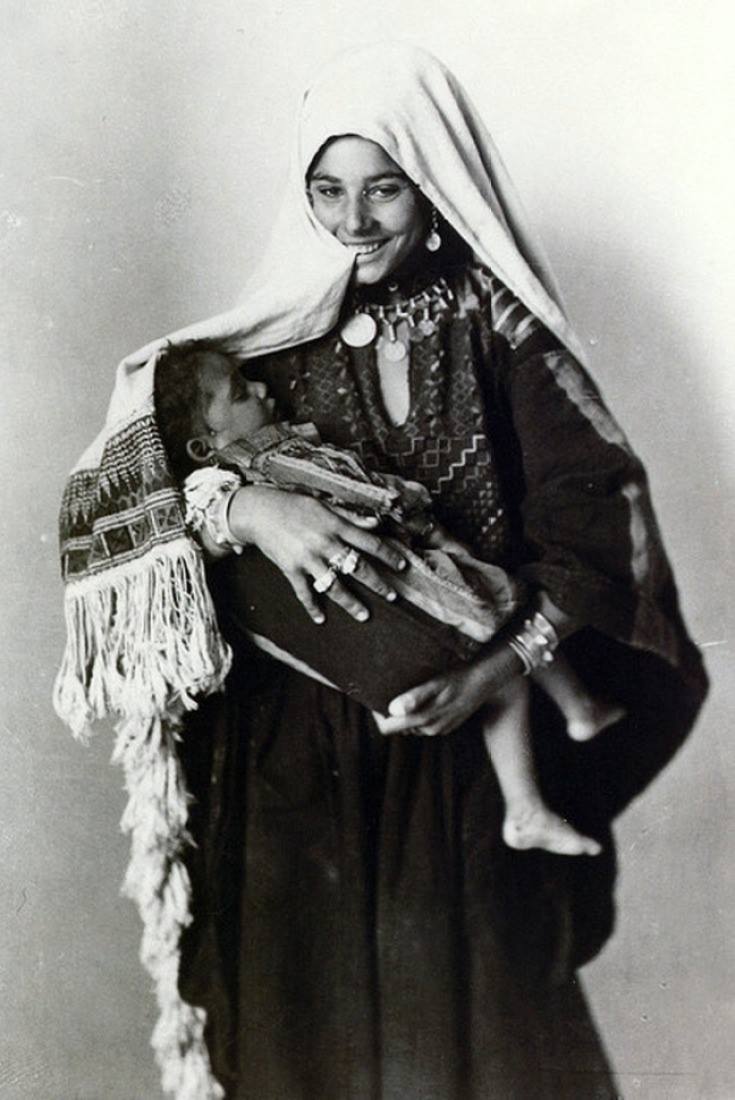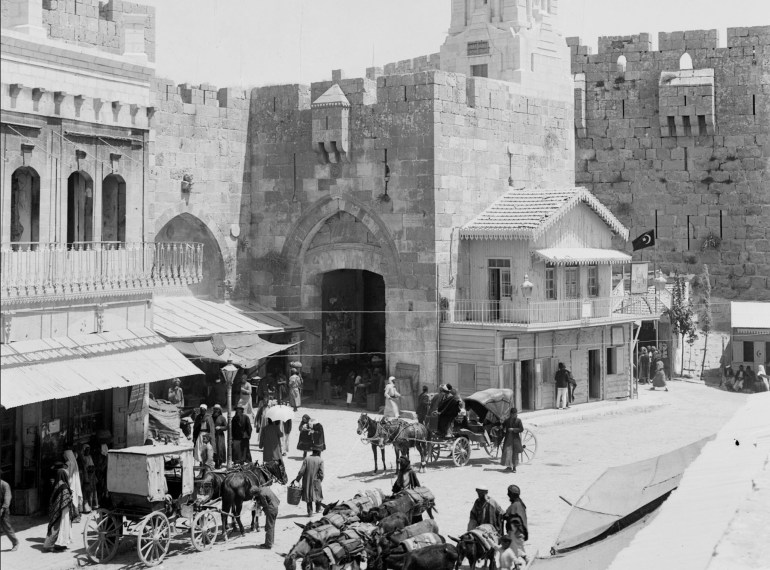The photo archive bringing pre-Nakba Jerusalem alive
Mona Hajjar Halaby’s British Mandate Jerusalemites photo library on Facebook captures often ignored history.
![Watermelon market outside Jaffa Gate at the base of the Citadel walls, Jerusalem, 1900 [BMJ]](/wp-content/uploads/2023/05/melons-2-1684148266.jpeg?resize=770%2C513&quality=80)
A Palestinian girl in traditional attire picks olives from a tree. A father and his three children dressed in their Sunday best pose for the camera.
These photos might otherwise be largely unremarkable, but they are part of a digital archive of life in Palestine before the Nakba, or Catastrophe, of 1948 when the creation of Israel led to the expulsion of more than 750,000 Palestinians from villages and towns that their ancestors had lived in for centuries.
Keep reading
list of 4 itemsPalestine: Banned in Berlin
Determined Palestinian youth pledge to fight for liberation
Palestine’s Abbas calls on UN to ‘suspend’ Israel as Nakba marked
The British Mandate Jerusalemites (BMJ) Photo Library on Facebook was created by Mona Hajjar Halaby, a Palestinian living in the US state of California. It has more than 26,000 followers and primarily shares photos of urban Jerusalemites during the British Mandate period of Palestine from the end of World War 1 until May 1948, though it also has pictures from before and after that period.
Halaby says she wants to “share with the world the fact that there was an intellectual, artistic, creative community in urban Palestine” at a time when 70 percent of Palestinians lived in villages, farming the land. She hopes the photos “break down the otherness” Westerners often feel towards Palestinians and show a shared humanity.
Halaby’s passion for black and white photos of Palestine comes from the stories she heard about her paternal uncle who left Palestine on May 14, 1948, the day before the Nakba officially began, with a suitcase full of photographs.
“Practically all he took in his small suitcase besides clean underwear and socks were his camera and all of his photos,” Halaby says.
Halaby remembers looking at her uncle’s photo collection with her mother, who told her stories about the photos and pointed out who’s who.
With the trove of photographs passed down to Halaby, she decided to create a Facebook page “to record for posterity’s sake that there was a vibrant society in Palestine in urban Jerusalem”.
Now, whenever she visits a Palestinian family, she asks them to dig up their old photographs so she can scan and post them to the BMJ Facebook page.
The particular poignancy of these photos is that they show a pre-Nakba Palestine, Halaby says. “Like an anthropologist,” Halaby says, “I’m digging. I want to understand the society that existed at that time.”
Halaby likes keeping the page as apolitical as possible. “It gets inflammatory the minute it gets political,” she says, adding that politics interferes with people’s ability to observe the photos with true empathy, so she often goes through and deletes any “vitriolic” comments.
The people of Palestine

The photograph above shows a Palestinian mother cradling her child, in the late 1920s. She wears traditional Palestinian garments. The photo was taken by the famous Palestinian photographer Khalil Raad.
A baby symbolises the future, a generation to come. What happened to the baby in this photo, who would have been at least 18 at the time of the Nakba: Did the child survive? Did the mother become a grandmother, or was her lineage abruptly interrupted by the cataclysmic events of 1948?
![A Greek Orthodox father and his three children, on Palm Sunday, in 1960s Jerusalem [Photo courtesy BMJ]](/wp-content/uploads/2023/05/Palm-east-1684140208.jpeg?w=770&resize=770%2C1104)
This photo from the 1960s captures a Greek Orthodox father and his three children on Palm Sunday when Christians carry candles and palm fronds as they participate in a procession along the same path that Jesus took as he entered Jerusalem.
The daughter is at the centre of the photo. Her tailored dress and neat braids offer a glimpse of Palestinian life that is often ignored by the mainstream media. Halaby tells Al Jazeera that this is especially true of “photos around the Nakba where you see a lot of peasants and labourers carrying their bundles as they are being forcibly relocated”. By highlighting photos of urban, well-off Palestinian families, Halaby says she wants to “make sure people can see the whole spectrum” of Palestinian lives.
The fact that this family is Christian also reveals another element of Palestinian identity – that it is not exclusively tied to a specific religion. Rather, Palestinian identity springs up from a connection with the land.
Control and conflict

Palestine was part of the Ottoman Empire for about 400 years from 1516 until 1918. This photo, taken around 1910, depicts a street scene outside Jaffa Gate in Jerusalem. The ancient walls of Jerusalem tower over the people going about their lives – two men talk next to a herd of heavy-laden donkeys and horses and buggies seem to be idling, waiting for the next customer. Someone walks towards Jaffa Gate with a white parasol for protection from the sun.
On the right side of the gate is a small flag with the star and crescent, the sign of Ottoman occupation. In 1922, the League of Nations granted the United Kingdom a mandate over Palestine with the provision that a home for Jews would one day be created in Palestine.
![[Photo by Eric and Edith Matson Photo Collection, Library of Congress, circa 1934 to 1939/BMJ]](/wp-content/uploads/2023/05/jeusalem-1684145614.jpeg?w=770&resize=643%2C614)
In this photo, a Royal Air Force Hawker Hardy K4059 of the No 6 Squadron RAF flies over Jerusalem. The photo depicts the modernisation of combat from rampart defence structures seen on the left to a lone combat plane patrolling the skies. Jerusalem, a city fought over for centuries, has seen the most advanced military technology of the times. Below the plane, the spire of St. Savior’s Church reaches upward.
![[Photo courtesy American Colony-Jerusalem-Photo Department/BMJ]](/wp-content/uploads/2023/05/riots1-1684145849.png?w=719&resize=524%2C664)
Uprisings against occupying forces have occurred throughout Palestine’s history. Captured in the photo above are riots at the New Gate in Jerusalem in 1933 against the sudden influx of Jewish immigrants fleeing Nazi persecution in Germany. Years later, the British built a metal barrier in the same gate to impose their control during the much larger Arab Revolt of 1938.
The parallels with more recent times are clear. In response to the Second Palestinian Intifada, or anti-occupation uprising, in 2001, Israel built checkpoints and roadblocks throughout Palestine. According to Mahsom Watch, a group of Israeli women who visit checkpoints to document when Israel’s military infringes on the rights of Palestinian civilians, there are currently 572 Israeli-imposed checkpoints and road closures in Palestine.
![[Photo courtesy BMJ]](/wp-content/uploads/2023/05/kennedu-1684146367.jpeg?w=720&resize=720%2C540)
The eyes of the world watch as conflict unfolds in Palestine. In this photo, a 22-year-old Robert F Kennedy is seen visiting Jerusalem in April 1948 to report on the tense situation for The Boston Post. According to the caption on BMJ, he is standing on Julian Way, a little north of the YMCA and the King David Hotel. Behind him, an armoured vehicle lumbers uphill, and barbed wire fences off a building to the left.
Religion, food and identity
![[Photo courtesy American Colony Photo Department, Library of Congress, 1938/BMJ]](/wp-content/uploads/2023/05/al-quds-1684146539.png?w=770&resize=770%2C531)
In Arabic, Jerusalem is called “al-Quds”, which translates to “the Holy”. It is a city that draws Muslim, Christian and Jewish devotees. The photo above depicts people leaving Friday prayers at Al-Aqsa Mosque. In 1938 when this photo was taken, there was no ambiguity around the mosque, and Muslims from across Palestine could come here to pray. However, even then it was a site for political expression.
Almost all the men in the photo are wearing the same headscarf, which was a symbol of Palestinian solidarity during the Arab Revolt of 1938.
![[Photo courtesy BMJ]](/wp-content/uploads/2023/05/olives-1684146961.jpeg?w=770&resize=770%2C1141)
Every element of this photo proudly proclaims Palestine. The girl is dressed in traditional Palestinian clothing, and she is picking olives.
Olive trees are a symbol of Palestinian identity and have been grown on these lands for centuries. The girl’s hands pull a branch laden with olives towards her. This action mirrors the way Palestinians today dearly protect their olive groves from bulldozing to maintain their time-worn connection to the land. As a reader commented below this picture on the Facebook page of the British Mandate Jerusalemites Photo Library: “Our tradition goes on and we pass it on to our children.”
Palestinian-American scholar Edward Said wrote in his book After the Last Sky, “The chances are today that one out of every two Palestinians you meet is descended from farmers or shepherds, and has deep roots in a land worked by small rural communities” Is this girl today someone’s grandmother or great-grandmother?
![[Photo courtesy BMJ]](/wp-content/uploads/2023/05/melons-1684147092.png?w=770&resize=770%2C548)
Here, a father and his children sit on an abundant harvest of watermelons. The boy in the middle holds out a cluster of grapes as if offering the viewer a taste. Even though the watermelons dominate the photo, the farmer is still on top, sitting on his bounty like a king.
Jerusalem: where biblical times coexist with modernity
![[Photo courtesy American Colony and Eric Matson Collection, Library of Congress, 1931/BMJ]](/wp-content/uploads/2023/05/balloon-1684147239.png?w=770&resize=770%2C553)
Taken on April 11, 1931, this image shows a German Zeppelin floating over Jerusalem. Underneath, an array of religious buildings fills Jerusalem’s skyline. Directly below the Zeppelin is the Church of the Holy Sepulcher. The Dome of the Rock can be seen just above the church’s dome. To the right of Al-Aqsa Mosque is the steeple of St John’s Lutheran Church of the Redeemer. In the background is the Mount of Olives and the Russian Ascension Church.
![[Photo courtesy: G. Eric and Edith Matson Photograph Collection, Library of Congress, 1918/BMJ]](/wp-content/uploads/2023/05/camels-1684147465.png?w=770&resize=770%2C504)
If the previous photo showed Jerusalem confronted by Western modernity, this photo depicts the opposite.
BMJ captions this photo: “Ancient, timeless and priceless …. a caravan of camels, carrying wheat, on their way to Jerusalem, 1918.”
Then as now, Jerusalem is a destination. A place where worlds collide.